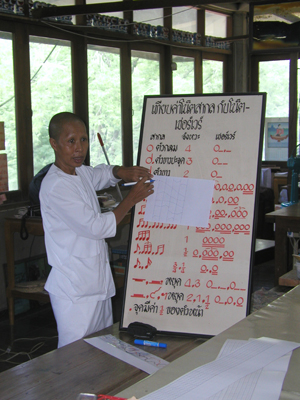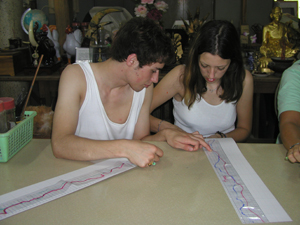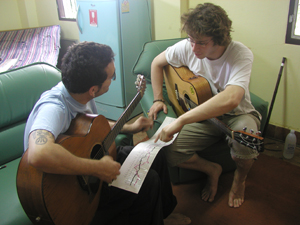Introduction to Laisenby Peter Radcliff In Thai, Laisen means signature, or autograph. It is also the name given to a unique method of composing music invented in the 1980s by Luang Por Charoen. The technique has been explored and developed since then by various monks and nuns at Thamkrabok, as well as interested laypeople and supporters, including a number of professional musicians, and academics from leading Thai universities and, more recently, by western musicians. Laisen is a method of producing melodies which can be used by any kind of musician or songwriter in any genre, classic or contemporary, eastern or western.
|
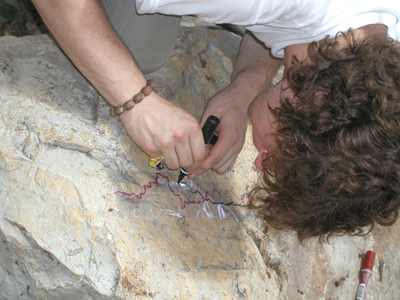 |
|
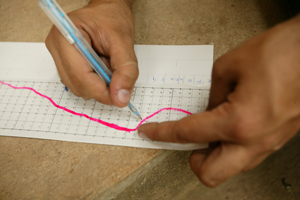 |
The technique is very simple in essence: the would-be composer of a Laisen tune starts by looking for any kind of natural formation (rocks, dry earth, trees, etc.) in which a line can be seen, and then transposes this into a melodic line. The method currently used at Thamkrabok is to take a transparent strip of cellophane about 1m long, lay it over the line, and trace it with a permanent marker. Often a second line from elsewhere will be traced on top of it in a different colour to see if they interact in any useful or interesting way. The completed strip is then stapled onto a strip of paper, on which has been printed a horizontal scale, representing time, and a vertical scale representing pitch, forming a grid. The standard size pre-printed at Thamkrabok plots the line over two octaves, and 16 bars of 4/4 time, subdivided into semiquavers, although obviously, any other note range, time signature, or number of bars could be used. The scale of pitches is given as numbers 1-7, rather than note names, and so can be interpreted as any scale - major, minor, or modal - that the composer wishes to use or, were the scale written differently, chromatic or microtonal melodies could be extracted.
|
|
But music is not a single flowing line, although it can sometimes subjectively seem to be. It is a series of events in time; so the next task is to determine where these discrete events occur. The Laisen composer looks at the traced line, and every point where it is perceived to change direction - any corner or angle - is marked as a note playing at the indicated pitch according to the vertical scale, at the rhythmic moment indicated by the horizontal time-scale. This can then be scored by either the Chinese-derived numeric notation system which is in general use at Thamkrabok, or by the western system. The melody can now be played on any instrument. Actually, it doesn't really matter how the notes are written, since by this stage it has already transformed into music. There is, in fact, a monk at Thamkrabok, Phra Santi, who is an accomplished piano player, and able to sight-read Laisen because of his long familiarity with them. Good results have also been achieved by inputting notes directly from the grid to the midi-editing window of music-production software on a computer, using their (fortuitous) visual similarity to bypass the steps of notating, and playing the tunes (although they may be replayed later for expression and dynamics).
|
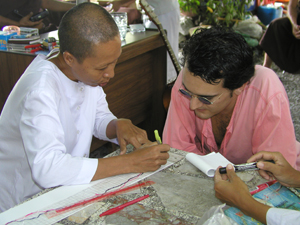 |
|
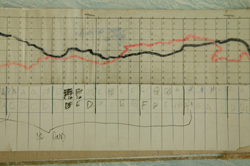 |
I won't go any further here with discussing the specifics of how the drawn line can turn into sound because there follows, for the benefit of musicians or anyone else who is interested, a link to a more in-depth discussion of different applications of Laisen to music-making, including non-melodic uses (which contain many interesting possibilities). What is important is that, however one chooses to work - be it playing and recording an instrument on the fly like a jazz or rock musician, scoring the notes for himself or another to play later like a classical composer, or going straight into the computer with mouse and keyboard like a dance-music producer - we now have a tune. |
|
All that remains now is for the composer to find a backing for the melody; adding rhythm and harmony, choosing which instruments should play it, and in what genre and musical context. This is where the musician is really challenged, and also where, for me, one of the most interesting aspects of Laisen composition resides, in that; it reverses the usual order in songwriting, in which the vast majority of writers already know roughly what kind of music they are going to try to create before they sit down to work. Laisen can take you somewhere you never expected to go, forcing one to abandon ingrained habits and lazy familiar choices in composition, which can make our work formulaic and predictable. To successfully use Laisen a musician must respond to and interact with them. What one takes, rejects, or adds, or alternatively how one adapts oneself around the line to make it work -- these are the factors which make the difference between a successful piece of music, and a random-sounding series of tones. That's all I can tell you about Laisen , except that it's by far the most stimulating thing I found in 15 years of professional music-making, and it came from someone who doesn't even do this full-time, but is also a meditator, a herbal doctor, a builder, a teacher, and an abbot in charge of over 100 monks. It's astonishing and unique. A friend and musician who I discussed it with once compared it to the "aleatory" music experiments done by Stockhausen and others where numbers were randomly generated by such means as rolling dice, but there's a kind of logic or internal coherence - with the occasional surprsing turn - which you find in a natural line, which seems to lend itself to music, and an interesting element of the different qualities of cracks which appear in different substances. Things manifest their nature in the precise way they begin to break up and decay, and so the more stable the substance, the calmer the music tends to be, just as more unstable substances, such as ice (which you don't much find in Thailand, except in drinks) tend to shatter apart, giving crazier tunes. But now I'm exceeding my brief and getting philosophical. Luang Por has stated that Laisen music is useful for healing and calming people, but I couldn't possibly comment on that aspect. From a straightforward musician's perspective it is extraordinary enough. |
|
|
musicians from the UK visited Thamkrabok as students of 'Laisen' |
September 2006 |
|
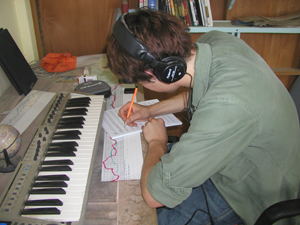 |
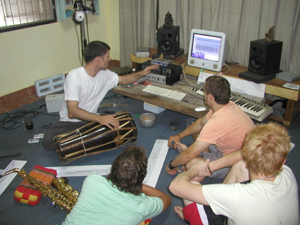 |
|
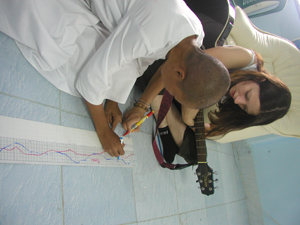 |
